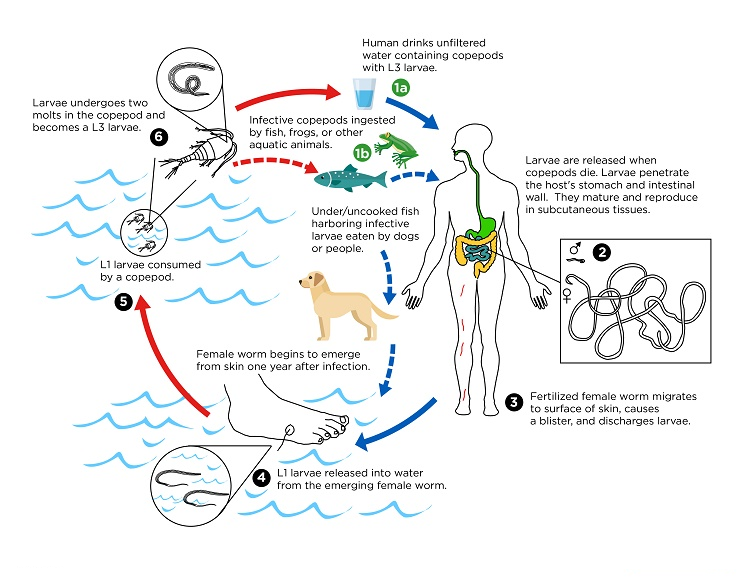Guinea Worm Disease | 26 Feb 2024
Why in News?
Recently, the World Health Organization’s (WHO) report has shed light on a remarkable milestone in global public health: the imminent eradication of Guinea worm disease.
- This parasitic infection, which plagued millions in the 1980s, has dwindled to just a handful of cases in recent years, signalling a triumph of human resilience and concerted eradication efforts.
What are the Key Facts About Guinea Worm Disease?
- About:
- Guinea worm disease, or Dracunculiasis is caused by the Guinea worm (Dracunculus medinensis), a parasitic nematode is a debilitating parasitic disease that renders infected individuals non-functional for weeks or months.
- It primarily affects people in rural, deprived, and isolated communities who rely on stagnant surface water sources for drinking.
- In the mid-1980s, an estimated 3.5 million cases of dracunculiasis occurred in 20 countries worldwide, mainly in Africa and Asia.
- Transmission, Symptoms and Impact:
- The parasite is transmitted when people drink stagnant water contaminated with parasite-infected water fleas.
- The disease manifests with painful skin lesions as the worm emerges, causing weeks of intense pain, swelling, and secondary infections.
- More than 90% of infections occur in the legs and feet, affecting individuals' mobility and ability to work or perform daily tasks.
- Prevention:
- There is no vaccine or medication to treat Guinea worm disease, but prevention strategies have been successful.
- Strategies include heightened surveillance, preventing transmission from each worm through treatment and wound care, filtering water before drinking, larvicide use, and health education.
- There is no vaccine or medication to treat Guinea worm disease, but prevention strategies have been successful.
- Road to Eradication:
- Efforts to eradicate Guinea worm disease began in the 1980s, with significant contributions from organisations like WHO.
- Countries are certified as free of dracunculiasis transmission after reporting zero instances for at least three consecutive years.
- Since 1995, WHO has certified 199 countries, territories, and areas as free of dracunculiasis transmission.
- Efforts to eradicate Guinea worm disease began in the 1980s, with significant contributions from organisations like WHO.
- India's Success Story:
- India achieved Guinea worm disease elimination in the late 1990s through rigorous public health measures, including water safety interventions and community education.
- Ongoing Surveillance and Challenges:
- Active surveillance is essential to ensure no cases are missed and to prevent the disease's re-emergence.
- Challenges persist in regions like Chad and the Central African Republic, where civil unrest and poverty hamper eradication efforts.
- Challenges include finding and containing the last remaining cases, particularly in remote areas, and addressing infections in animals, notably dogs.
UPSC Civil Services Examination, Previous Year Questions (PYQs)
Prelims:
Q.1 Consider the following diseases: (2014)
- Diphtheria
- Chickenpox
- Smallpox
Which of the above diseases has/have been eradicated in India?
(a) 1 and 2 only
(b) 3 only
(c) 1, 2 and 3
(d) None
Ans: (b)
Exp:
- Smallpox is the only disease among the given diseases that has been eradicated from India.
- Smallpox was an infectious disease caused by the Variola virus. Early symptoms include high fever and fatigue. The virus then produces a characteristic rash, particularly on the face, arms and legs. The resulting spots become filled with clear fluid and later, pus, and then form a crust, which eventually dries up and falls off. The last naturally occurring case of smallpox was diagnosed in 1977.
- Diphtheria is an infectious disease caused by the bacterium Corynebacterium diphtheria, which primarily infects the throat and upper airways, and produces a toxin affecting other organs. It is preventable by vaccines. Diphtheria cases are still very common in India.
- Varicella, also commonly referred to as chickenpox, is an acute and highly contagious disease. It is caused by primary infection with the Varicella-zoster virus. Its cases are still found in India. Hence, 2 is correct.
- Therefore, option (b) is the correct answer.
Mains
Q. Critically examine the role of WHO in providing global health security during the Covid-19 pandemic. (2020)


